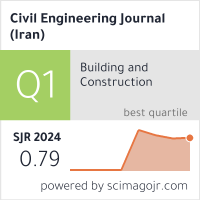XGBoost-SHAP and Unobserved Heterogeneity Modelling of Temporal Multivehicle Truck-Involved Crash Severity Patterns
Downloads
Doi:10.28991/CEJ-2024-010-06-011
Full Text:PDF
Downloads
[2] NESDB. (2012). Structure of the GDP. National Economic & Social Development Board (NESDB), Bangkok, Thailand.
[3] DOH. (2024). Thailand traffic accident on national highways. Thailand Department of Highways (DOH), Bangkok, Thailand.
[4] Chen, C., Zhang, G., Tian, Z., Bogus, S. M., & Yang, Y. (2015). Hierarchical Bayesian random intercept model-based cross-level interaction decomposition for truck driver injury severity investigations. Accident Analysis and Prevention, 85, 186–198. doi:10.1016/j.aap.2015.09.005.
[5] Islam, S., Jones, S. L., & Dye, D. (2014). Comprehensive analysis of single- and multi-vehicle large truck at-fault crashes on rural and urban roadways in Alabama. Accident Analysis and Prevention, 67, 148–158. doi:10.1016/j.aap.2014.02.014.
[6] Pahukula, J., Hernandez, S., & Unnikrishnan, A. (2015). A time of day analysis of crashes involving large trucks in urban areas. Accident Analysis and Prevention, 75, 155–163. doi:10.1016/j.aap.2014.11.021.
[7] Zou, W., Wang, X., & Zhang, D. (2017). Truck crash severity in New York city: An investigation of the spatial and the time of day effects. Accident Analysis and Prevention, 99, 249–261. doi:10.1016/j.aap.2016.11.024.
[8] Hao, W., Kamga, C., Yang, X., Ma, J. Q., Thorson, E., Zhong, M., & Wu, C. (2016). Driver injury severity study for truck involved accidents at highway-rail grade crossings in the United States. Transportation Research Part F: Traffic Psychology and Behaviour, 43, 379–386. doi:10.1016/j.trf.2016.09.001.
[9] Khan, W. A., & Khattak, A. J. (2018). Injury Severity of Truck Drivers in Crashes at Highway-Rail Grade Crossings in the United States. Transportation Research Record, 2672(10), 38–47. doi:10.1177/0361198118781183.
[10] Al-Bdairi, N. S. S., Hernandez, S., & Anderson, J. (2018). Contributing Factors to Run-Off-Road Crashes Involving Large Trucks under Lighted and Dark Conditions. Journal of Transportation Engineering, Part A: Systems, 144. doi:10.1061/jtepbs.0000104.
[11] Uddin, M., & Huynh, N. (2017). Truck-involved crashes injury severity analysis for different lighting conditions on rural and urban roadways. Accident Analysis and Prevention, 108, 44–55. doi:10.1016/j.aap.2017.08.009.
[12] Ahmed, M. M., Franke, R., Ksaibati, K., & Shinstine, D. S. (2018). Effects of truck traffic on crash injury severity on rural highways in Wyoming using Bayesian binary logit models. Accident Analysis and Prevention, 117, 106–113. doi:10.1016/j.aap.2018.04.011.
[13] Behnood, A., & Mannering, F. (2019). Time-of-day variations and temporal instability of factors affecting injury severities in large-truck crashes. Analytic Methods in Accident Research, 23, 100102. doi:10.1016/j.amar.2019.100102.
[14] Song, D., Yang, X., Yang, Y., Cui, P., & Zhu, G. (2023). Bivariate joint analysis of injury severity of drivers in truck-car crashes accommodating multilayer unobserved heterogeneity. Accident Analysis and Prevention, 190, 107175. doi:10.1016/j.aap.2023.107175.
[15] Uddin, M., & Huynh, N. (2020). Injury severity analysis of truck-involved crashes under different weather conditions. Accident Analysis and Prevention, 141, 105529. doi:10.1016/j.aap.2020.105529.
[16] Shao, X., Ma, X., Chen, F., Song, M., Pan, X., & You, K. (2020). A random parameter ordered probit analysis of injury severity in truck involved rear-end collisions. International Journal of Environmental Research and Public Health, 17(2), 395. doi:10.3390/ijerph17020395.
[17] Tahmidul Haq, M., Zlatkovic, M., & Ksaibati, K. (2021). Assessment of Commercial Truck Driver Injury Severity as a Result of Driving Actions. Transportation Research Record: Journal of the Transportation Research Board, 2675(9), 1707–1719. doi:10.1177/03611981211009880.
[18] Haq, M. T., Zlatkovic, M., & Ksaibati, K. (2021). Assessment of commercial truck driver injury severity based on truck configuration along a mountainous roadway using hierarchical Bayesian random intercept approach. Accident Analysis & Prevention, 162, 106392. doi:10.1016/j.aap.2021.106392.
[19] Wang, C., Chen, F., Zhang, Y., & Cheng, J. (2022). Spatiotemporal instability analysis of injury severities in truck-involved and non-truck-involved crashes. Analytic Methods in Accident Research, 34, 100214. doi:10.1016/j.amar.2022.100214.
[20] Santos, K., Dias, J. P., & Amado, C. (2022). A literature review of machine learning algorithms for crash injury severity prediction. Journal of Safety Research, 80, 254–269. doi:10.1016/j.jsr.2021.12.007.
[21] Chang, L. Y., & Chien, J. T. (2013). Analysis of driver injury severity in truck-involved accidents using a non-parametric classification tree model. Safety Science, 51(1), 17–22. doi:10.1016/j.ssci.2012.06.017.
[22] Zheng, Z., Lu, P., & Lantz, B. (2018). Commercial truck crash injury severity analysis using gradient boosting data mining model. Journal of Safety Research, 65, 115–124. doi:10.1016/j.jsr.2018.03.002.
[23] Zhang, S., Khattak, A., Matara, C. M., Hussain, A., & Farooq, A. (2022). Hybrid feature selection-based machine learning Classification system for the prediction of injury severity in single and multiple-vehicle accidents. PLoS ONE, 17(2), 262941. doi:10.1371/journal.pone.0262941.
[24] Rahimi, E., Shamshiripour, A., Samimi, A., & Mohammadian, A. (Kouros). (2020). Investigating the injury severity of single-vehicle truck crashes in a developing country. Accident Analysis and Prevention, 137, 105444. doi:10.1016/j.aap.2020.105444.
[25] Islam, M., & Hernandez, S. (2013). Large truck-involved crashes: Exploratory injury severity analysis. Journal of Transportation Engineering, 139(6), 596–604. doi:10.1061/(ASCE)TE.1943-5436.0000539.
[26] Dong, C., Richards, S. H., Huang, B., & Jiang, X. (2013). Identifying the factors contributing to the severity of truck-involved crashes. International Journal of Injury Control and Safety Promotion, 22(2), 116–126. doi:10.1080/17457300.2013.844713.
[27] Naik, B., Tung, L. W., Zhao, S., & Khattak, A. J. (2016). Weather impacts on single-vehicle truck crash injury severity. Journal of Safety Research, 58, 57–65. doi:10.1016/j.jsr.2016.06.005.
[28] Osman, M., Paleti, R., Mishra, S., & Golias, M. M. (2016). Analysis of injury severity of large truck crashes in work zones. Accident Analysis & Prevention, 97, 261–273. doi:10.1016/j.aap.2016.10.020.
[29] Dong, C., Dong, Q., Huang, B., Hu, W., & Nambisan, S. S. (2017). Estimating Factors Contributing to Frequency and Severity of Large Truck–Involved Crashes. Journal of Transportation Engineering, Part A: Systems, 143. doi:10.1061/jtepbs.0000060.
[30] Al-Bdairi, N. S. S., & Hernandez, S. (2017). An empirical analysis of run-off-road injury severity crashes involving large trucks. Accident Analysis and Prevention, 102, 93–100. doi:10.1016/j.aap.2017.02.024.
[31] Wang, Y., & Prato, C. G. (2019). Determinants of injury severity for truck crashes on mountain expressways in China: A case-study with a partial proportional odds model. Safety Science, 117, 100–107. doi:10.1016/j.ssci.2019.04.011.
[32] Haq, M. T., Zlatkovic, M., & Ksaibati, K. (2020). Investigating occupant injury severity of truck-involved crashes based on vehicle types on a mountainous freeway: A hierarchical Bayesian random intercept approach. Accident Analysis & Prevention, 144, 105654. doi:10.1016/j.aap.2020.105654.
[33] Wen, H., Ma, Z., Chen, Z., & Luo, C. (2023). Analyzing the impact of curve and slope on multi-vehicle truck crash severity on mountainous freeways. Accident Analysis & Prevention, 181, 106951. doi:10.1016/j.aap.2022.106951.
[34] Mannering, F., Bhat, C. R., Shankar, V., & Abdel-Aty, M. (2020). Big data, traditional data and the tradeoffs between prediction and causality in highway-safety analysis. Analytic Methods in Accident Research, 25, 100113. doi:10.1016/j.amar.2020.100113.
[35] Mannering, F. L., Shankar, V., & Bhat, C. R. (2016). Unobserved heterogeneity and the statistical analysis of highway accident data. Analytic Methods in Accident Research, 11, 1–16. doi:10.1016/j.amar.2016.04.001.
[36] Hou, Q., Huo, X., Leng, J., & Mannering, F. (2022). A note on out-of-sample prediction, marginal effects computations, and temporal testing with random parameters crash-injury severity models. Analytic Methods in Accident Research, 33, 100191. doi:10.1016/j.amar.2021.100191.
[37] Se, C., Champahom, T., Jomnonkwao, S., Karoonsoontawong, A., & Ratanavaraha, V. (2021). Temporal stability of factors influencing driver-injury severities in single-vehicle crashes: A correlated random parameters with heterogeneity in means and variances approach. Analytic Methods in Accident Research, 32, 100179. doi:10.1016/j.amar.2021.100179.
[38] Goswamy, A., Abdel-Aty, M., & Islam, Z. (2023). Factors affecting injury severity at pedestrian crossing locations with Rectangular RAPID Flashing Beacons (RRFB) using XGBoost and random parameters discrete outcome models. Accident Analysis and Prevention, 181, 106937. doi:10.1016/j.aap.2022.106937.
[39] Jamal, A., Zahid, M., Tauhidur Rahman, M., Al-Ahmadi, H. M., Almoshaogeh, M., Farooq, D., & Ahmad, M. (2021). Injury severity prediction of traffic crashes with ensemble machine learning techniques: a comparative study. International Journal of Injury Control and Safety Promotion, 28(4), 408–427. doi:10.1080/17457300.2021.1928233.
[40] Train, K. E. (2009). Discrete choice methods with simulation. Cambridge university press, Cambridge, United Kingdom.
[41] Sarrias, M. (2016). Discrete choice models with random parameters in R: The Rchoice package. Journal of Statistical Software, 74(10), 1–31. doi:10.18637/jss.v074.i10.
[42] Washington, S., Karlaftis, M. G., Mannering, F., & Anastasopoulos, P. (2020). Statistical and econometric methods for transportation data analysis. Chapman and Hall/CRC, Boca Raton, United States.
[43] Greene, W. H., & Hensher, D. A. (2010). Modeling ordered choices: A primer. Cambridge University Press, Cambridge, United Kingdom.
[44] Chen, T., & Guestrin, C. (2016). XGBoost. Proceedings of the 22nd ACM SIGKDD International Conference on Knowledge Discovery and Data Mining. doi:10.1145/2939672.2939785.
[45] Friedman, J. H. (2001). Greedy function approximation: A gradient boosting machine. The Annals of Statistics, 29(5), 1189-1232. doi:10.1214/aos/1013203451.
[46] Dong, S., Khattak, A., Ullah, I., Zhou, J., & Hussain, A. (2022). Predicting and Analyzing Road Traffic Injury Severity Using Boosting-Based Ensemble Learning Models with SHAPley Additive exPlanations. International Journal of Environmental Research and Public Health, 19(5), 2925. doi:10.3390/ijerph19052925.
[47] Lundberg, S. M., & Lee, S. I. (2017). A unified approach to interpreting model predictions. Advances in Neural Information Processing Systems, 30.
[48] Yu, H., Li, Z., Zhang, G., Liu, P., & Ma, T. (2021). Fusion convolutional neural network-based interpretation of unobserved heterogeneous factors in driver injury severity outcomes in single-vehicle crashes. Analytic Methods in Accident Research, 30, 100157. doi:10.1016/j.amar.2021.100157.
[49] Mokhtarimousavi, S., Anderson, J. C., Azizinamini, A., & Hadi, M. (2020). Factors affecting injury severity in vehicle-pedestrian crashes: A day-of-week analysis using random parameter ordered response models and Artificial Neural Networks. International Journal of Transportation Science and Technology, 9(2), 100–115. doi:10.1016/j.ijtst.2020.01.001.
[50] Sokolova, M., & Lapalme, G. (2009). A systematic analysis of performance measures for classification tasks. Information Processing & Management, 45(4), 427–437. doi:10.1016/j.ipm.2009.03.002.
[51] Ryu, S. E., Shin, D. H., & Chung, K. (2020). Prediction model of dementia risk based on XGBoost using derived variable extraction and hyper parameter optimization. IEEE Access, 8, 177708–177719. doi:10.1109/ACCESS.2020.3025553.
[52] Wu, S., Yuan, Q., Yan, Z., & Xu, Q. (2021). Analyzing Accident Injury Severity via an eXtreme Gradient Boosting (XGBoost) Model. Journal of Advanced Transportation, 2021, 1–11. doi:10.1155/2021/3771640.
[53] Champahom, T., Jomnonkwao, S., Watthanaklang, D., Karoonsoontawong, A., Chatpattananan, V., & Ratanavaraha, V. (2020). Applying hierarchical logistic models to compare urban and rural roadway modeling of severity of rear-end vehicular crashes. Accident Analysis & Prevention, 141, 105537. doi:10.1016/j.aap.2020.105537.
[54] Rifaat, S. M., Tay, R., & De Barros, A. (2012). Severity of motorcycle crashes in Calgary. Accident Analysis & Prevention, 49, 44–49. doi:10.1016/j.aap.2011.02.025.
[55] Se, C., Champahom, T., Jomnonkwao, S., Chonsalasin, D., & Ratanavaraha, V. (2024). Modeling of single-vehicle and multi-vehicle truck-involved crashes injury severities: A comparative and temporal analysis in a developing country. Accident Analysis & Prevention, 197, 107452. doi:10.1016/j.aap.2023.107452.
[56] Se, C., Champahom, T., Jomnonkwao, S., Kronprasert, N., & Ratanavaraha, V. (2022). The impact of weekday, weekend, and holiday crashes on motorcyclist injury severities: Accounting for temporal influence with unobserved effect and insights from out-of-sample prediction. Analytic Methods in Accident Research, 36, 100240. doi:10.1016/j.amar.2022.100240.
[57] Se, C., Champahom, T., Jomnonkwao, S., Chaimuang, P., & Ratanavaraha, V. (2021). Empirical comparison of the effects of urban and rural crashes on motorcyclist injury severities: A correlated random parameters ordered probit approach with heterogeneity in means. Accident Analysis & Prevention, 161, 106352. doi:10.1016/j.aap.2021.106352.
[58] Zhu, X., & Srinivasan, S. (2011). A comprehensive analysis of factors influencing the injury severity of large-truck crashes. Accident Analysis & Prevention, 43(1), 49–57. doi:10.1016/j.aap.2010.07.007.
[59] Alrejjal, A., Farid, A., & Ksaibati, K. (2021). A correlated random parameters approach to investigate large truck rollover crashes on mountainous interstates. Accident Analysis & Prevention, 159, 106233. doi:10.1016/j.aap.2021.106233.
[60] Mehrara Molan, A., Rezapour, M., & Ksaibati, K. (2020). Investigating the relationship between crash severity, traffic barrier type, and vehicle type in crashes involving traffic barrier. Journal of Traffic and Transportation Engineering (English Edition), 7(1), 125–136. doi:10.1016/j.jtte.2019.03.004.
[61] Hao, W., Kamga, C., & Wan, D. (2016). The effect of time of day on driver's injury severity at highway-rail grade crossings in the United States. Journal of Traffic and Transportation Engineering, 3(1), 37–50. doi:10.1016/j.jtte.2015.10.006.
[62] Mohamad, I., Jomnonkwao, S., & Ratanavaraha, V. (2022). Using a decision tree to compare rural versus highway motorcycle fatalities in Thailand. Case Studies on Transport Policy, 10(4), 2165–2174. doi:10.1016/j.cstp.2022.09.016.
[63] Chen, F., & Chen, S. (2011). Injury severities of truck drivers in single- and multi-vehicle accidents on rural highways. Accident Analysis & Prevention, 43(5), 1677–1688. doi:10.1016/j.aap.2011.03.026.
- Authors retain all copyrights. It is noticeable that authors will not be forced to sign any copyright transfer agreements.
- This work (including HTML and PDF Files) is licensed under a Creative Commons Attribution 4.0 International License.![]()















